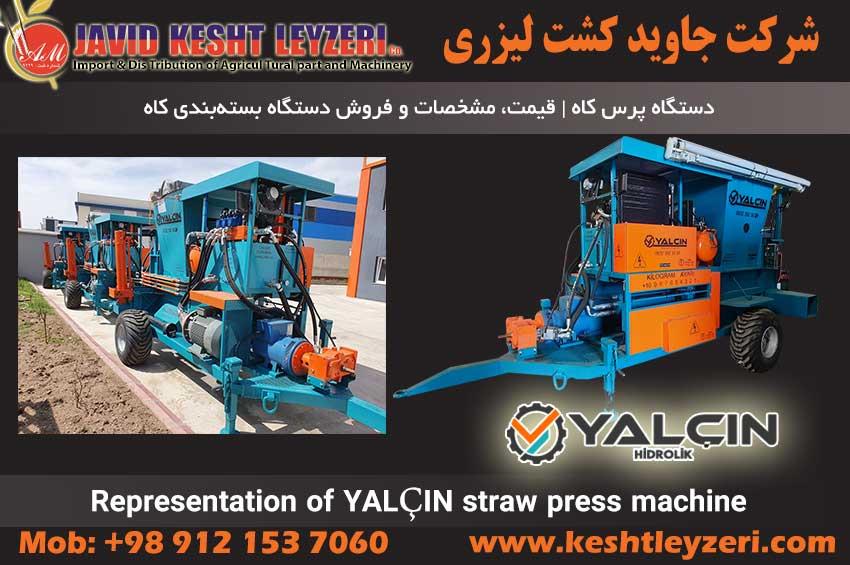سیلاژ گیاه خارشتر یک فرایند تهیه علوفه است که از گیاه خارشتر به منظور نگهداری و ذخیره سازی بهتر مصرف میشود. در این فرایند، گیاه خارشتر به صورت خرد شده و با افزودن عوامل نگهدارنده، در محیط بستهبندی شده و در شرایط آناerobic (بدون حضور هوا) به فرایند تخمیر تحت میپذیرد. این روش ذخیرهسازی میتواند برای حفظ و استفاده از خواص تغذیهای گیاه در طول فصول غیرمناسب مفید باشد. به عنوان مثال، در فصل زمستان که ممکن است دسترسی به علوفههای تازه محدود باشد.
لیست مطالب این بخش:
- سیلاژ خارشتر علوفه ای چیست؟
- سیلاژ خارشتر علوفه ای چه خصوصیاتی دارد؟
- سیلاژ خارشتر علوفه ای چگونه تهیه می شود؟
- بسته بندی سیلاژ خارشتر چگونه انجام می پذیرد؟
- سیلاژ علوفه خارشتر برای چه دام ها و پرندگانی مناسب است؟
- ارزش غذایی سیلاژ علوفه خارشتر چقدر است؟
در ادامه مطالب فوق بررسی خواهند شد.
برای دریافت اطلاعات در مورد دستگاه بسته بندی علوفه و دستگاه سیلاژ علوفه، قیمت خرید دستگاه بسته بندی علوفه و مشاوره خرید کافی است با مدیر فروش شرکت جناب آقای مهندس مردانی با شماره همراه 09121537060 تماس بگیرید و یا از طریق پیام رسان ایتا و واتساپ به ایشان پیام ارسال نمایید.
کلمات کلیدی: قیمت دستگاه سیلاژ علوفه,قیمت دستگاه بسته بندی علوفه,فروش دستگاه سیلاژ علوفه,فروش دستگاه بسته بندی علوفه,خرید دستگاه سیلاژ علوفه,خرید دستگاه بسته بندی علوفه,دستگاه بسته بندی علوفه,دستگاه سیلاژ علوفه,دستگاه سیلاژ ذرت علوفه ای,دستگاه سیلاژ تفاله مالت,دستگاه سیلاژ ذرت,دستگاه بسته بندی ذرت علوفه ای,قیمت دستگاه سیلاژ ذرت علوفه ای,قیمت دستگاه سیلاژ,فروش دستگاه سیلاژ,دستگاه سیلاژ تفاله چغندرقند,دستگاه بسته بندی تفاله چغندرقند ,دستگاه سیلاژ یونجه,قیمت دستگاه سیلاژ یونجه,فروش دستگاه سیلاژ یونجه,قیمت دستگاه سیلاژ مالت علوفه ای,خرید دستگاه سیلاژ یونجه
سیلاژ خارشتر علوفه، یک نوع علوفه سیلاژ است که از گیاه خارشتر (Alhagi maurorum) تهیه میشود. در این روش، خارشتر به صورت خرد شده به همراه مواد دیگر مخصوص سیلاژ تهیه میشود تا به یک علوفه خوراکی با کیفیت بالا تبدیل گردد.
سیلاژ خارشتر علوفه ای چه خصوصیاتی دارد؟
خصوصیات سیلاژ خارشتر علوفه عبارتند از:
-
حاوی عناصر غذایی: سیلاژ خارشتر حاوی انواع مختلفی از عناصر غذایی از جمله پروتئین، فیبر، کربوهیدرات، و ویتامینها میباشد.
-
مخزن انرژی: این نوع سیلاژ به دلیل حاوی کربوهیدراتهای قابل تجزیه و سوخت، میتواند به عنوان یک مخزن انرژی مؤثر برای دامها عمل کند.
-
پذیرش خوب: معمولاً سیلاژ خارشتر به دلیل خرد شدن و آماده شدن برای مصرف، پذیرش خوبی نسبت به دامها دارد.
-
ماندگاری طولانی: در صورت ذخیرهسازی صحیح و مدیریت مناسب، سیلاژ خارشتر میتواند ماندگاری طولانی داشته باشد و به عنوان یک منبع غذایی پایدار برای دامها مورد استفاده قرار گیرد.
-
تاثیر مثبت بر کارایی دام: مصرف سیلاژ خارشتر به عنوان یک جزء از جیره تغذیهای میتواند به بهبود کارایی دامها، افزایش وزن، و تولید شیر کمک کند.
-
منبع اقتصادی: گیاه خارشتر به عنوان یک منبع قابل تأمین و اقتصادی در برخی مناطق مورد کشت و استفاده قرار میگیرد؛ بنابراین، سیلاژ حاصل از آن نیز میتواند یک راهکار اقتصادی برای تأمین خوراک دام باشد.
توجه داشته باشید که برای بهترین نتایج، در تهیه و مصرف سیلاژ خارشتر علوفه، رعایت دقیق ترکیبات و شرایط ذخیرهسازی ضروری است.
سیلاژ خارشتر علوفه ای چگونه تهیه می شود؟
تهیه سیلاژ خارشتر علوفه به مراحل زیر اختصاص دارد:
۱. انتخاب و برداشت گیاهان: برای تهیه سیلاژ خارشتر، گیاهان خارشتر باید در مرحله گلدهی و قبل از تشکیل میوه (بذر) برداشت شوند. این مرحله زمانی است که گیاهان دارای بیشترین مواد غذایی و کیفیت هستند.
۲. خرد کردن گیاهان: گیاهان خارشتر باید به قطعات کوچک خرد شوند تا سهولت در مخزن سیلاژ و همچنین در فرآیند تجزیه و هضم دامها افزایش یابد. این خرد کردن میتواند با استفاده از تجهیزات خردکننده مکانیکی انجام شود.
۳. افزودن مواد تحریکی و آب: برای بهبود فرآیند خمیر شدن و فراهم کردن شرایط ساخت سیلاژ، ممکن است به مواد تحریکی مانند ملاس (آب آبگوشته) یا آب افزوده شود. این مرحله به بهبود فرآیند تجزیه و تخمیر کمک کرده و میزان مواد خنثی کننده (pH) را در سیلاژ تنظیم میکند.
۴. بسته بندی و فشردهسازی: گیاهان خرد شده به همراه مواد تحریکی در یک مخزن یا سیلو قرار میگیرند. این مواد به دقت در لایههایی درون مخزن چیده میشوند و به طور مکرر فشرده میشوند. این فشردگی کمک به حذف هواهای موجود در مخزن و ایجاد شرایط بدون اکسیژن برای فرآیند سیلاژ شدن میکند.
۵. تحت فشار گذاشتن سطح: بعد از افزودن لایههای جدید، سطح سیلاژ تحت فشار قرار داده میشود. این فشار کمک به حذف بیشتر هواها از داخل سیلاژ میکند.
۶. پوشش سطح: پس از فشردهسازی نهایی، سطح سیلاژ با یک لایه پوششی مثل پلاستیک برپوشانده میشود تا اکسیژن از داخل مخزن خارج شود و پایداری سیلاژ افزایش یابد.
۷. ذخیرهسازی: سپس سیلاژ خارشتر در مخازن یا سیلوها به مدت زمان معین (معمولاً چند هفته تا چند ماه) برای فرآیند سیلاژ شدن ذخیره میشود.
توجه: در هر مرحله، به رعایت بهداشت و شرایط بهینه تهیه و ذخیرهسازی سیلاژ توجه کنید تا بهترین نتیجه بهدست آید.
بسته بندی سیلاژ خارشتر چگونه انجام می پذیرد؟
بستهبندی سیلاژ خارشتر معمولاً به صورت کلی در قالب مراحلی انجام میشود. در اینجا چند مرحله اصلی برای بستهبندی سیلاژ خارشتر آورده شده است:
۱. انتقال به مکان بستهبندی: پس از فرآیند سیلاژ گیری و تهیه، سیلاژ به مکان بستهبندی انتقال مییابد. این ممکن است یک واحد تولید یا کارخانه بستهبندی باشد.
۲. انتقال به دستگاه بستهبندی: سیلاژ به دستگاه بستهبندی مناسب منتقل میشود. این دستگاهها میتوانند از نوع اتوماتیک یا نیمه اتوماتیک باشند.
۳. اندازهگیری و وزن کنترلی: در این مرحله، مقدار مشخصی از سیلاژ برای بستهبندی تعیین میشود. همچنین وزن کنترلی انجام میشود تا هر بسته دقیقاً به وزن مشخصی بسته شود.
۴. بستهبندی: سیلاژ به بستههای مناسب بستهبندی میشود. این بستهها ممکن است از جنس پلاستیک باشند که مقاومت کافی در برابر عوامل محیطی دارد.
۵. پوشش و مهر بندی: بستهها پس از بستهبندی بهطور دقیق پوشش داده میشوند تا از تماس با هوا و رطوبت محیط جلوگیری شود. همچنین، معمولاً بر روی بستهها مهری به عنوان نشانه کیفیت و اصالت محصول قرار میگیرد.
۶. ذخیره سازی: بستههای سیلاژ خارشتر پس از بستهبندی به انبارها یا مخازنی که شرایط محیطی مطلوب دارند، انتقال مییابند. ذخیرهسازی در شرایط مناسب مهم است تا کیفیت سیلاژ حفظ شود.
توجه: هر یک از مراحل بستهبندی باید با دقت و با رعایت استانداردها و شرایط بهداشتی انجام شود تا محصول نهایی در بهترین حالت به دست مصرفکننده برسد.
سیلاژ علوفه خارشتر برای چه دام ها و پرندگانی مناسب است؟
سیلاژ علوفه خارشتر به عنوان یک منبع خوراکی مناسب میتواند برای چندین نوع دام و پرندگان مورد استفاده قرار بگیرد. این شامل:
۱. گاوها و گاومیشها: سیلاژ علوفه خارشتر به عنوان یک جزء از جیره غذایی برای گاوها و گاومیشها میتواند مناسب باشد. این سیلاژ به دلیل محتوای نسبتاً بالای پروتئین و ارزش تغذیهای مناسب خود، میتواند به بهبود ترکیب جیره و افزایش تولید شیر در گاوهای شیری کمک کند.
۲. گوسفندان و بزها: سیلاژ خارشتر برای گوسفندان و بزها نیز مناسب است. این علوفه میتواند به عنوان یک جزء از رژیم غذایی آنان در دورههای مختلف مانند آبستنی، شیردهی و رشد استفاده شود.
۳. شترها: در مناطق کویری و خشک، سیلاژ خارشتر به عنوان یک منبع خوراکی مناسب برای شترها مورد استفاده قرار میگیرد. این گیاه به دلیل تحمل به شرایط خشکی و مقاومت در برابر کمآبی، یک گزینه مناسب برای شترهاست.
۴. مرغها و جوجهها: در برخی موارد، سیلاژ خارشتر ممکن است به عنوان یک جزء از تغذیه مرغها و جوجهها نیز استفاده شود. اما باید توجه داشت که این گیاه ممکن است برای برخی از پرندگان قابلیت گوارش مناسب نداشته باشد و نیاز به تعدیل در جیره داشته باشد.
توجه به تنوع جیره، توان گوارشی دام یا پرنده مورد نظر، و شرایط محیطی مهم است تا از بهترین استفاده از سیلاژ علوفه خارشتر بهرهمند شود.
ارزش غذایی سیلاژ علوفه خارشتر چقدر است؟
ارزش غذایی سیلاژ علوفه خارشتر به عنوان یک منبع خوراکی مهم برای دامها و پرندگان مطالعه شده است. این ارزش غذایی ممکن است متغیر باشد و به عواملی مانند شرایط زراعت، مرحله رشد گیاه، و نحوه تهیه و ذخیرهسازی بستگی داشته باشد. در اجمال، ارزش غذایی سیلاژ علوفه خارشتر به ترتیب میتواند شامل موارد زیر باشد:
-
پروتئین: سیلاژ علوفه خارشتر معمولاً حاوی مقدار قابل توجهی پروتئین است که این ویژگی میتواند برای دامها و پرندگان مناسب باشد.
-
فیبر: حاوی مقدار قابل توجهی فیبر، که ممکن است به گوارش بهتر دامها کمک کند.
-
مواد معدنی: شامل مواد معدنی مانند فسفر که برای سلامت استخوانها و دیگر عملکردهای بدنی حیوانات ضروری است.
-
انرژی: سیلاژ خارشتر به عنوان یک منبع انرژی نیز مورد استفاده قرار میگیرد.
برای اطلاعات دقیقتر و مناسبتر برای وضعیت خاص، توصیه میشود که تجزیه و تحلیل تغذیهای از نمونههای خاص سیلاژ علوفه خارشتر مورد بررسی قرار گیرد یا به دیتاهای تحقیقاتی موجود در این زمینه مراجعه شود.
برای دریافت اطلاعات در مورد دستگاه بسته بندی علوفه و دستگاه سیلاژ علوفه، قیمت خرید دستگاه بسته بندی علوفه و مشاوره خرید کافی است با مدیر فروش شرکت جناب آقای مهندس مردانی با شماره همراه 09121537060 تماس بگیرید و یا از طریق پیام رسان ایتا و واتساپ به ایشان پیام ارسال نمایید.
کلمات کلیدی: قیمت دستگاه سیلاژ علوفه,قیمت دستگاه بسته بندی علوفه,فروش دستگاه سیلاژ علوفه,فروش دستگاه بسته بندی علوفه,خرید دستگاه سیلاژ علوفه,خرید دستگاه بسته بندی علوفه,دستگاه بسته بندی علوفه,دستگاه سیلاژ علوفه,دستگاه سیلاژ ذرت علوفه ای,دستگاه سیلاژ تفاله مالت,دستگاه سیلاژ ذرت,دستگاه بسته بندی ذرت علوفه ای,قیمت دستگاه سیلاژ ذرت علوفه ای,قیمت دستگاه سیلاژ,فروش دستگاه سیلاژ,دستگاه سیلاژ تفاله چغندرقند,دستگاه بسته بندی تفاله چغندرقند ,دستگاه سیلاژ یونجه,قیمت دستگاه سیلاژ یونجه,فروش دستگاه سیلاژ یونجه,قیمت دستگاه سیلاژ مالت علوفه ای,خرید دستگاه سیلاژ یونجه







